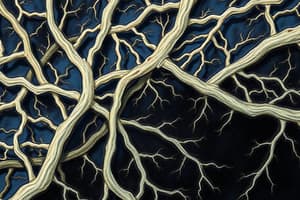Podcast
Questions and Answers
What is one of the primary functions of connective tissue?
What is one of the primary functions of connective tissue?
- Regulating metabolism
- Insulation (correct)
- Generating electrical impulses
- Producing hormones
Which of the following is NOT a type of connective tissue?
Which of the following is NOT a type of connective tissue?
- Cartilage
- Bone
- Nerve (correct)
- Blood
What is the primary component that all connective tissues have in common?
What is the primary component that all connective tissues have in common?
- Epithelial cells
- Muscle fibers
- Ground substance (correct)
- Nerve fibers
What role do proteoglycans play in connective tissue?
What role do proteoglycans play in connective tissue?
What is the origin of connective tissue?
What is the origin of connective tissue?
Which type of collagen is primarily found in skin, tendon, and bone?
Which type of collagen is primarily found in skin, tendon, and bone?
What is a primary characteristic of elastic fibers in connective tissue?
What is a primary characteristic of elastic fibers in connective tissue?
What distinguishes fibrocartilage from hyaline cartilage?
What distinguishes fibrocartilage from hyaline cartilage?
What is a function of bone tissue?
What is a function of bone tissue?
Which of the following structures is part of the axial skeleton?
Which of the following structures is part of the axial skeleton?
What role does cartilage play in the body?
What role does cartilage play in the body?
Calcification of cartilage primarily occurs due to:
Calcification of cartilage primarily occurs due to:
Which type of collagen serves as part of the basal laminae?
Which type of collagen serves as part of the basal laminae?
Flashcards
Connective Tissue Function
Connective Tissue Function
Connective tissues have several functions, including binding and supporting, protection, insulation, storing, and transporting.
Connective Tissue Types
Connective Tissue Types
Connective tissue is categorized into connective tissue proper, cartilage, bone, and blood (technically).
Connective Tissue Origin
Connective Tissue Origin
Most connective tissues originate from mesenchyme during embryonic development.
Connective Tissue Matrix
Connective Tissue Matrix
Signup and view all the flashcards
Connective Tissue Components
Connective Tissue Components
Signup and view all the flashcards
Collagen Function
Collagen Function
Signup and view all the flashcards
Elastic Fiber Function
Elastic Fiber Function
Signup and view all the flashcards
Cartilage Properties
Cartilage Properties
Signup and view all the flashcards
Hyaline Cartilage Location
Hyaline Cartilage Location
Signup and view all the flashcards
Bone Composition
Bone Composition
Signup and view all the flashcards
Axial Skeleton Function
Axial Skeleton Function
Signup and view all the flashcards
Bone Marrow Function
Bone Marrow Function
Signup and view all the flashcards
Fibrocartilage Location
Fibrocartilage Location
Signup and view all the flashcards
Study Notes
Connective Tissue
- Connective tissues are diverse tissues with multiple functions, including binding & supporting, protection, insulation, storage, and transport.
- Four main types: connective tissue proper, cartilage, bone, and blood.
- Originate from mesenchyme (embryonic tissue).
- Vary in vascularity.
- All have an extracellular matrix separating living cells, providing resistance to stress.
- Comprised of three main components: ground substance, fibres, and cells.
Ground Substance
- Unstructured material filling spaces between cells.
- Contains interstitial fluid, cell adhesion proteins (e.g., holding cells to the matrix), and proteoglycans.
- Proteoglycans have a protein core with glycosaminoglycans (GAGs).
- GAGs are negatively charged, trapping water, increasing viscosity (e.g., hyaluronic acid).
Fibres
- Provide support to structures.
- Collagen: Strongest and most common, most abundant animal protein. Forms bundles, cross-links for high tensile strength. Types differ in structure and location.
- Type I: skin, tendons, bone, ligaments, dentin
- Type II: cartilage, vitreous humor
- Type III: skin, muscle, blood vessels
- Type IV: basal laminae
- Type IX: cartilage, vitreous humor
- Elastic: Long, thin, branching network. Allow stretch (elastin) limited by collagen. Return to original shape when relaxed. Found in skin, lungs, blood vessels.
- Reticular: Continuous, branched network of collagen fibers. Provides support around blood vessels and soft tissues.
Cartilage
- Resists tension and compression.
- Density falls between connective tissue and bone.
- Lacks nerves and blood vessels (repair slow).
- Calcifies (turns to bone) with age.
- Types:
- Hyaline: Most common; supports, reinforces. Found in ends of long bones, nose, larynx, trachea.
- Elastic: Similar to hyaline but with more elastic fibers. Maintains shape while flexible; found in ear (pinna), epiglottis.
- Fibrocartilage: Less dense than hyaline. Compressible and resists tension; absorbs compressive shock, withstands pressure. Found in intervertebral discs, knee.
Bone
- Also called osseous tissue, provides support and protection.
- Contains cavities for fat storage & blood cell synthesis.
- Matrix similar to cartilage but denser.
- Contains calcium salts (bone salts).
- Has central canals with blood vessels and nerves.
Bone Functions
- Anchorage: Attachment site for skeletal muscles. Forms levers.
- Production: Haematopoiesis (blood formation) in bone marrow.
- Hormones: Influences insulin secretion, glucose homeostasis, and energy use.
- Storage: Triglycerides (energy store), calcium, and phosphates (blood ions replenishment).
Skeleton
- Two groups:
- Axial: Forms central axis of the body (skull, vertebral column, ribcage). Provides protection and support.
- Appendicular: Includes upper and lower limbs, and girdles (shoulders and hips). Primarily for locomotion and movement.
Studying That Suits You
Use AI to generate personalized quizzes and flashcards to suit your learning preferences.




